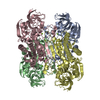+Search query
-Structure paper
| Title | Active and stable alcohol dehydrogenase-assembled hydrogels via synergistic bridging of triazoles and metal ions. |
|---|---|
| Journal, issue, pages | Nat Commun, Vol. 14, Issue 1, Page 2117, Year 2023 |
| Publish date | Apr 13, 2023 |
 Authors Authors | Qiang Chen / Ge Qu / Xu Li / Mingjian Feng / Fan Yang / Yanjie Li / Jincheng Li / Feifei Tong / Shiyi Song / Yujun Wang / Zhoutong Sun / Guangsheng Luo /  |
| PubMed Abstract | Biocatalysis is increasingly replacing traditional methods of manufacturing fine chemicals due to its green, mild, and highly selective nature, but biocatalysts, such as enzymes, are generally ...Biocatalysis is increasingly replacing traditional methods of manufacturing fine chemicals due to its green, mild, and highly selective nature, but biocatalysts, such as enzymes, are generally costly, fragile, and difficult to recycle. Immobilization provides protection for the enzyme and enables its convenient reuse, which makes immobilized enzymes promising heterogeneous biocatalysts; however, their industrial applications are limited by the low specific activity and poor stability. Herein, we report a feasible strategy utilizing the synergistic bridging of triazoles and metal ions to induce the formation of porous enzyme-assembled hydrogels with increased activity. The catalytic efficiency of the prepared enzyme-assembled hydrogels toward acetophenone reduction is 6.3 times higher than that of the free enzyme, and the reusability is confirmed by the high residual catalytic activity after 12 cycles of use. A near-atomic resolution (2.1 Å) structure of the hydrogel enzyme is successfully analyzed via cryogenic electron microscopy, which indicates a structure-property relationship for the enhanced performance. In addition, the possible mechanism of gel formation is elucidated, revealing the indispensability of triazoles and metal ions, which guides the use of two other enzymes to prepare enzyme-assembled hydrogels capable of good reusability. The described strategy can pave the way for the development of practical catalytic biomaterials and immobilized biocatalysts. |
 External links External links |  Nat Commun / Nat Commun /  PubMed:37055470 / PubMed:37055470 /  PubMed Central PubMed Central |
| Methods | EM (single particle) |
| Resolution | 2.12 Å |
| Structure data | EMDB-33514, PDB-7xy9: |
| Chemicals |  ChemComp-ZN:  ChemComp-MG:  ChemComp-HOH: |
| Source |
|
 Keywords Keywords | OXIDOREDUCTASE / Coordination complex / Activity / Stability / Enzyme Immobilization |
 Movie
Movie Controller
Controller Structure viewers
Structure viewers About Yorodumi Papers
About Yorodumi Papers






 thermoanaerobacter brockii (bacteria)
thermoanaerobacter brockii (bacteria)